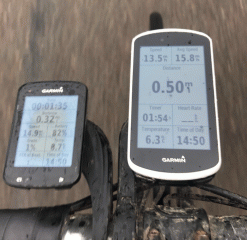Upgrading to the Garmin Edge 1030
My previous on-bike device is a Garmin Edge 820, so that is what I'll be comparing my new computer to.
First impressions
On the surface, the Edge 1030 isn't fundamentally different to the 820. Sure, it's bigger (a lot bigger, really) but it features the same general user interface and controls. On the rear mount it has special exposed pins that allow it to be connected to an extra battery pack, but otherwise it charges the same as the 820 - with a standard micro-USB cable.
In more detail

It's important to reiterate that the 1030 is a lot bigger than the 820, and this can lead to problems with mounting it in the same place on each bike that you're used to. I had to shift one of my mounts (that was on the handlebar stem) as the steerer spacers were now getting in the way. The original out-front mount that came with the 820 does just about make it work, although the 1030 does nudge against the front of the bar stem.
Battery drain is so much better than with the 820. I would be lucky to squeeze out a seven ride (whilst navigating) without recharging mid-way, but now the battery isn't even half down. Two things to note here: (1) this is a new device, and the battery will be running at 100% capacity; (2) this sort of battery drain is still regarded as terrible by the Lezyne crowd, who expect a good 24h+ of use on a single charge.
Of course, having a bigger screen is great - especially for the map view, which now has an extra option for showing the elevation profile at the same time!
The major improvement over the 820 is the touch-screen. The 820 does have a reputation for a screen with fairly poor touch response, and from new I found it worse than my old Edge Explore device. The Edge 1030's touch screen is a huge improvement though, as it is responsive and interprets the different gestures correctly. It also works well when I'm wearing gloves - always a peeve with the 820, which was particularly temperamental with gloves.
It's not just that the gestures are picked up much more reliably: the device also responds much more smoothly. The 820 could be quite laggy, when switching screens, and the map screen could also take up to 10 or 20 seconds to update when it appeared. Combined with the non-ideal gesture detection, the 820 required a bit of patience.
In conclusion
Despite offering broadly the same functionality, these two devices really present themselves quite differently. The Edge 820 is about as small as you can get away with, and it needs good eyes to read the map. Its size also means that the smaller battery impacts run-time. The Edge 1030 is the "ideal" size; any bigger and it would be just too big to fit on the bars.

